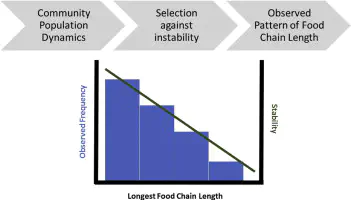Why there are so few trophic levels: Selection against instability explains the pattern
 Graphical abstract
Graphical abstract
Abstract
Food chains are short, rarely more than five trophic levels long. The cause of this pattern remains unresolved, and no current hypothesis fully explains this phenomenon. We offer an explanation based on the stability of food chains that have been shifted away from linearity to be more web-like. We start with a simple example of food webs of two to six species arranged so that species consume all those with a trophic level less than their own. The probability of stability, for such universal omnivory chains declined strongly with chain length, and was as low as 1% with six level chains but highest for two and three level chains. We further explored the influence of chain length on food web stability by testing food webs with varying levels of connectance that were constructed either randomly or with the niche model. By additionally altering the relative impacts of predators on prey, and vice-versa, we test the role of our assumptions on the relationship between chain length and stability. Food webs characterized by low to moderate degrees of connectance, asymmetrical interactions, and relatively weak density dependence showed a pattern of reduced stability with longer trophic chains. The simple view that food webs characterized by long trophic chains are less stable seems to resolve the long-standing question of why there are so few trophic levels in nature.